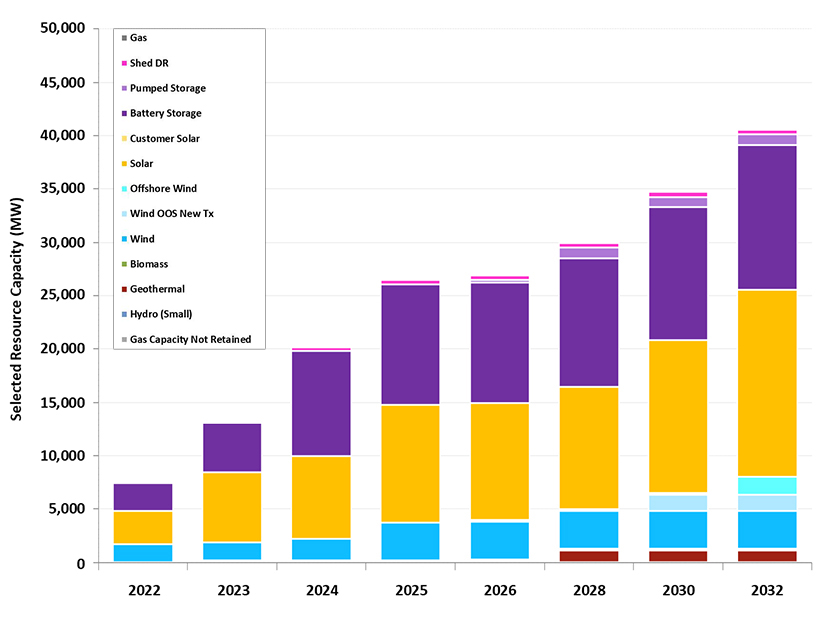
The California Public Utilities Commission on Thursday ordered a steep reduction in greenhouse gas emissions by the electricity sector over the next decade and adopted a plan to add 40 GW of new resources, at an estimated cost of $49 billion, to get there.
The decision adopting the new preferred system plan completed the second half of the commission’s multiyear integrated resource planning process, which began in 2019.
It called for the electricity sector to meet a new goal of limiting greenhouse gas emissions to 38 million metric tons in 2030 and 35 MMT in 2032. The new 2032 target is 23% lower than the 46-MMT goal that the CPUC set in the two prior years to its current IRP cycle. (See CPUC Triples Resource Projections for CAISO Tx Plan.)
Commissioner Clifford Rechtschaffen, the lead commissioner in the IRP proceeding, said the new target represented a major step forward in the state’s effort to combat climate change.
If California can meet the goal, “it means in 2032, our grid will be 86% greenhouse gas free,” and that 73% of resources in the state portfolio will be renewables, Rechtschaffen said.
“We have been doing extremely well in reducing greenhouse gas emissions in the electricity sector,” he said. “Emissions from that sector have declined by close to 50% over the last decade. This decision ensures that we’ll continue that trend into the next decade.”
The electricity sector, including in-state generation and out-of-state imports, accounts for about 15% of GHG emissions in California. Transportation (40%) and industry (about 20%) are the two biggest polluters.
The state has a legislative mandate to reduce overall GHG emissions, including from transportation and industry, by 40% below 1990 levels through 2030. The state emitted a total of 418.2 MMT in 2019, the latest year for which accurate data are available.
Transmission Planning
The decision also asked CPUC staff to explore, in cooperation with CAISO and the California Energy Commission, what it would take to reach an even lower 30-MMT target.
“Through the study of this case, we hope to learn more about the transmission buildout and cost implications of the lower GHG target, which we may consider for adoption for the years after 2030,” Administrative Law Judge Julie Fitch wrote.
For now, “an important reason that we develop this resource portfolio is to have it considered by the CAISO for transmission planning purposes,” Fitch said. “Adopting the 38-MMT portfolio while continuing to analyze deeper GHG emissions-reduction scenarios allows us to proceed in an orderly, step-to-step fashion to build out the grid infrastructure needed to support future generation and storage projects.”
A preliminary analysis by commission staff showed “there is sufficient space for all of these new resources on the existing transmission system, with only limited transmission upgrades needed by 2032,” the CPUC said in a news release. “This finding will be validated at a more granular level by [CAISO] in its 2022-2023 transmission planning process.”
Rechtschaffen praised CAISO for having identified two storage projects in last year’s transmission planning process that could eliminate the need for new transmission.
“It’s a creative solution, and it’s a cost-effective solution,” he said.
Resource Procurement
California will need a vast increase in generation and storage resources to meet the new GHG target and the state’s goal of serving retail customers with 60% clean energy by 2030 and 100% by 2045, as required by 2018’s Senate Bill 100.
“The 38-MMT target represents a major resource buildout that requires approximately a 40% increase in net qualifying capacity [NQC] of the electric system in the state within less than a decade,” Fitch wrote. “To achieve this portfolio, an average of approximately 4,000 MW of new capacity in NQC will need to be added each and every year through 2032.”
In her decision Fitch estimated the cost of adding 40 GW of new resources at nearly $49 billion.
In adopting the decision, the CPUC approved a resource portfolio that includes 25.5 GW of new renewable resources and 15 GW of new storage and demand response resources by 2032 — “enough clean energy to power approximately 11.5 million homes,” the commission said.
The figures include 11.5 GW of new resources that the CPUC ordered load-serving entities, including the state’s three big investor-owned utilities and its community choice aggregators, to procure by 2026 last June. (See CPUC Orders Additional 11.5 GW but No Gas.)
The commission’s forecasts of resources needed to meet the state’s climate goals have increased significantly in recent years.
In 2020, the CPUC adopted a reference system portfolio in its IRP proceeding that called for 25 GW of renewable energy and storage by 2030. Last year it said the state will need 28 GW of generation and storage by 2031 under the previous 46-MMT target.
The new plan calling for 40 GW accounts for the new 38-MMT target and anticipates a high penetration of electric vehicles by 2032. It includes additional solar power, totaling 17.5 GW, and more battery storage, reaching 13.5 GW. It also incorporates 1 GW of long-duration storage, 1.2 GW of geothermal energy, 1.7 GW of offshore wind and 1.5 GW of out-of-state wind.
Unlike the first phase of the CPUC’s 2019-21 IRP, the second phase took the current and planned resource portfolios of more than 50 LSEs into account to forecast procurement needs through 2032.
“The first half of this IRP cycle analyzed and adopted an optimal portfolio of electricity resources as a guide for LSEs to use for meeting their GHG, reliability and cost objectives,” the commission said. “The second half of the IRP cycle … is designed to consider the portfolios and actions that each LSE proposes for meeting these goals — to allow the CPUC to review each LSE plan and aggregate LSE portfolios to develop a preferred system plan portfolio, and to consider whether further action by the LSEs, such as additional procurement, is needed to meet state goals.”


